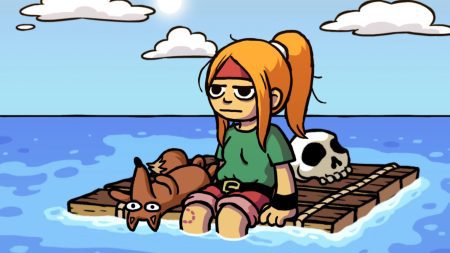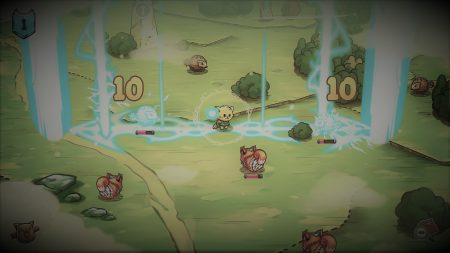A Punny, Satisfying Adventure Through the Fantastical Kingdom of Felingrad
In the land of Felingrad, there are cats, there are puns, and there is magic. This is the essence of Cat Quest, a 2D action-RPG from the Gentlebros (and published by PQube) that was recently nominated for GooglePlay’s 2017 Indie Game of the Year.
The game puts you in the shoes of an unnamed cat hero shortly after he sees his sister kidnapped by the sinister villain Drakoth, a white cat of unimaginable power and mysterious origin. Before you know it, you’re fighting mighty dragons and slinging powerful spells on your quest to save your sis and foil Drakoth’s scheme.
Cat Quest is, in a word, charming. While it doesn’t hit the target every time, it gets so much right that it’s difficult to deny how damn fun the game is. Let’s get to it!
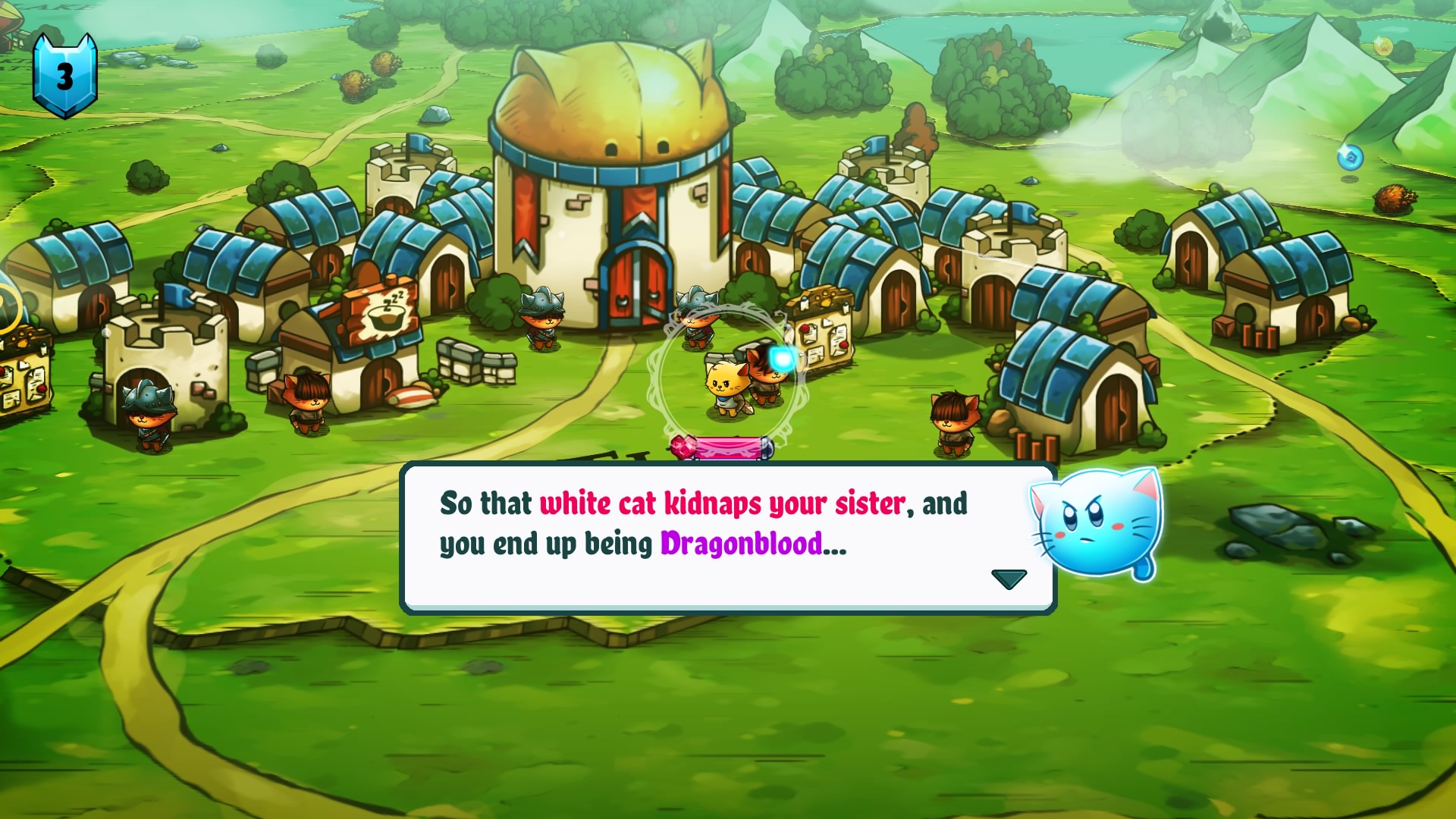
I Could Probably Do That
Story time: On the banks of the Pawcific Ocean, in the sleepy coastal village of East Pawt, I rise from my catnap. With my mighty purple sword in hand, I trudge southwest toward an island in the middle of a bay, where the entrance to a lone cave—called Lonely Cave, actually—dominates the isle’s geography.
Cats hate water, naturally, but this does not concern me. My paws never touch the surface. I levitate across the bay, from shore to shore, until I’m standing in front of the mouth of Lonely Cave.
There is an indicator over the mouth of the cave that warns me of what I’m about to face. “Lv. 200”. That’s almost three times my feeble level 70. The disparity is so large that I don’t really understand the significance of it, other than the general idea that this particular cave offers extreme difficulty, and probably equally powerful loot. Indeed, there is a lone golden chest within the cave. And that golden chest happens to be guarded by, among other things, a particularly fur-ocious monster. (I promise this is the only time I will make a cat pun throughout this review. Maybe.)
I know I can do this. I have the power. I want that treasure! I charge in, dodging like a mad man, getting just close enough to set my foes ablaze and land the occasional sword swipe while avoiding traps and the wickedly fast attacks from this beast and its companions. I down the riff-raff and get the monster’s health down a sliver. My health is nearly maxed. I’m feeling good about this.
Then, suddenly, I dodge the wrong direction. The monster’s spell lands on top of me, doing damage that extends well beyond my total hit points. The monster kills me rather matter-of-factly. And it will the next time. In fact, when all is said and done, the great beast of Lonely Cave will have killed me 8 times. Fortunately, through the inexplicable graciousness of game design, I awake each time from a catnap, along the bank of the Pawcific Ocean, in the sleepy coastal village of East Pawt.
Eventually, I will kill the monster inside the cave, looting a treasure that turns out to be so powerful that I become a sort of demi-god, able to deliver so much damage so quickly that nothing in the game even has a chance to kill me. I will have become the very embodiment of the monster I tried so hard to slay. But I’m getting ahead of myself.
One of the greatest successes in Cat Quest’s design is its ability to convey a balanced sense of power to the player. Whether through offensive might, deft dodging, or just sheer patience, every battle feels like one in which the player can prevail, despite the constant threat of death from enemies who—even at equivalent levels to yours—all deal out significant damage in relation to your own health. In short, dying is easy, but so is the killing.
In Felingrad, It’s Kill…
In terms of pure gameplay, Cat Quest is its combat. In fact, the game pushes the player away from anything that doesn’t involve killing. (This isn’t a bad thing, but we’ll get to it in a bit.) On the player’s end, attacking involves a choice between melee attacks and an assortment of magic spells, while defending is performed by dodging or just staying the hell out the way.
Generally speaking, I am in love with magic systems. In games, books, or movies, if there is a magic system, I want to know what makes it tick. As it turns out, Cat Quest’s magic system is the defining characteristic of combat within the game, for better or worse.
Every spell has its own unique area of effect indicated by dark red patterns extending out from beneath the caster. The pattern then fills up or flashes with a bright red progress bar, which indicates charge time and varies a little depending on who or what is casting the spell. (Unless you’re the one casting, in which case the charge-time is reduced to zero regardless of what spell you’re using.)
The system is aesthetically and mechanically pleasing and offers some strategic choices for the player in more difficult dungeons. Unfortunately, the seven spells in the game are not all equally represented, nor do some of them appear to have any practical use beyond being a collectible.

The player’s end of the magic system is simply lacking in depth. I found the fire spell to be most useful of the seven, as it causes damage-over-time to affected targets in addition to the base damage caused by the initial attack. Eventually, I started using the lightning spell, too, if for no other reason than the range that came along with the spell was occasionally convenient. But I could’ve played the entire game with just the fire spell, not even bothering with the other six. There isn’t much incentive to try out new spells, one of which is a healing spell that is almost completely negated by the far superior armor recharge mechanic, which occurs automatically.
You can argue that the different spells mean people with different approaches can find a combination that works for them, but it’s not unreasonable to expect that when there are only seven spells, the player should be able to clearly see the benefit of each one and find a use for them within the game world. As it stands, there is just no situation where I need to use, say, a void attack spell that deals damage in an x pattern, when I could just as easily use fire for everything.
The melee attacks, for their part, seem primarily designed to supplement the magic. Landing physical hits is your sole means of recharging your magic points in combat. It’s certainly not impossible to customize a Dragonblood build that emphasizes physical damage over magic, but in my experience, magic spells consistently did far more damage to most enemy types, so I always focused on weapons and armor that boosted magic abilities, even if it was at the expense of strength.
I would have liked to have seen a system that offered a more diverse range of practical applications for the spells and melee abilities. But make no mistake: the system that is in place—however bare—is still a lot of fun. So fun, in fact, that after I finished my play through for this review, I went back in and earned my Platinum Trophy. Even after getting it, I still goofed around in the hardest dungeons, seeing how quickly I could clear them.
…Or Be Killed.
Fortunately, like any magic system, there is another side: the magic that your foes wield. This is where combat really shines and where the magic system redeems itself. All those spells and patterns we talked about earlier? Your enemies have them, too. If you’re encountering those enemies in small numbers, you can dodge most attacks fairly easily, since they’re clearly telegraphed to the player. On the other hand, if you encounter a few at once (or a particularly powerful one), combat will quickly turn into exhilarating chaos, testing your ability to stay in control.
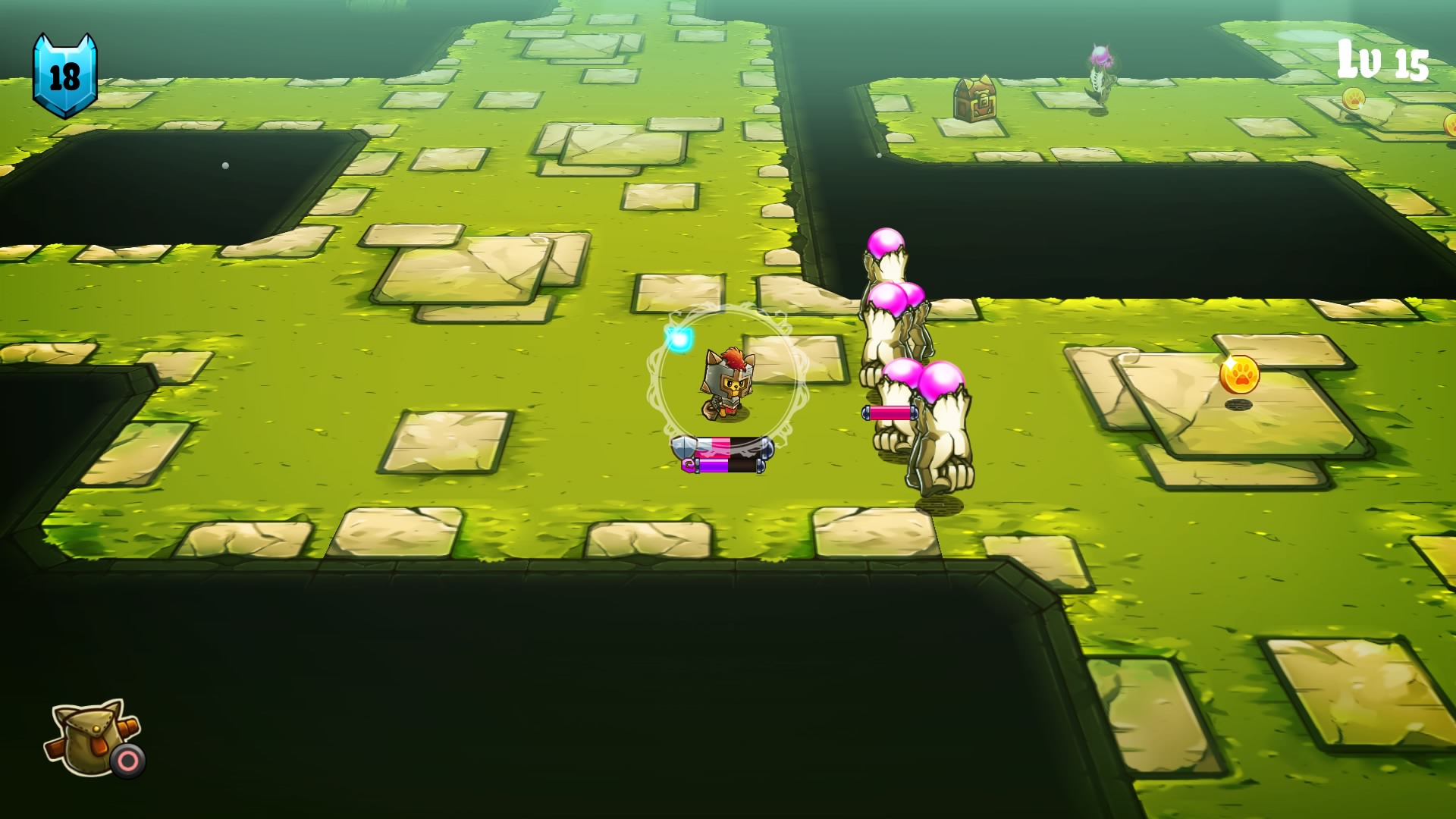
If you’re in tight spaces, this is doubly true, as dodging then becomes a spatial issue in addition to a timing one. These situations are perhaps the most fun in the game, and the moments where the player feels the most empowered, dodging through ranks of enemy attacks, throwing out magic spells or swinging one of the many melee weapons you pick up throughout your journey. These mechanics seem to work smoothly in any combination.
Keeping the Player Playing
As I mentioned earlier, Cat Quest doesn’t seem to want the player spending too much time not fighting things or dungeon diving. One of the ways in which the game achieves this is through a simple and incredibly clever item management system.
In addition to melee weapons, players can also equip a helmet and chest piece, all of which have their own archetypes that contribute to or detract from one or more of the player’s four base stats: health, armor, strength, or magic. The degree to which those archetypes influence the stats is determined by the piece’s level.
To prevent player inventories from getting bogged down with duplicates of any of the 66 individual pieces of gear in the game, the level of any additional versions of the same piece are just added to the one you already have. This means if you collect a level 3 Samewrai katana, then find a level 15 Samewrai katana later on, you’ll suddenly have yourself a level 18 version.
In addition to saving you time managing inventory, this also means that literally anytime you pick up an item, regardless of what it is, you are either finding a brand-new piece of equipment or making an old one stronger. In Cat Quest, every step, no matter how small, is progress.
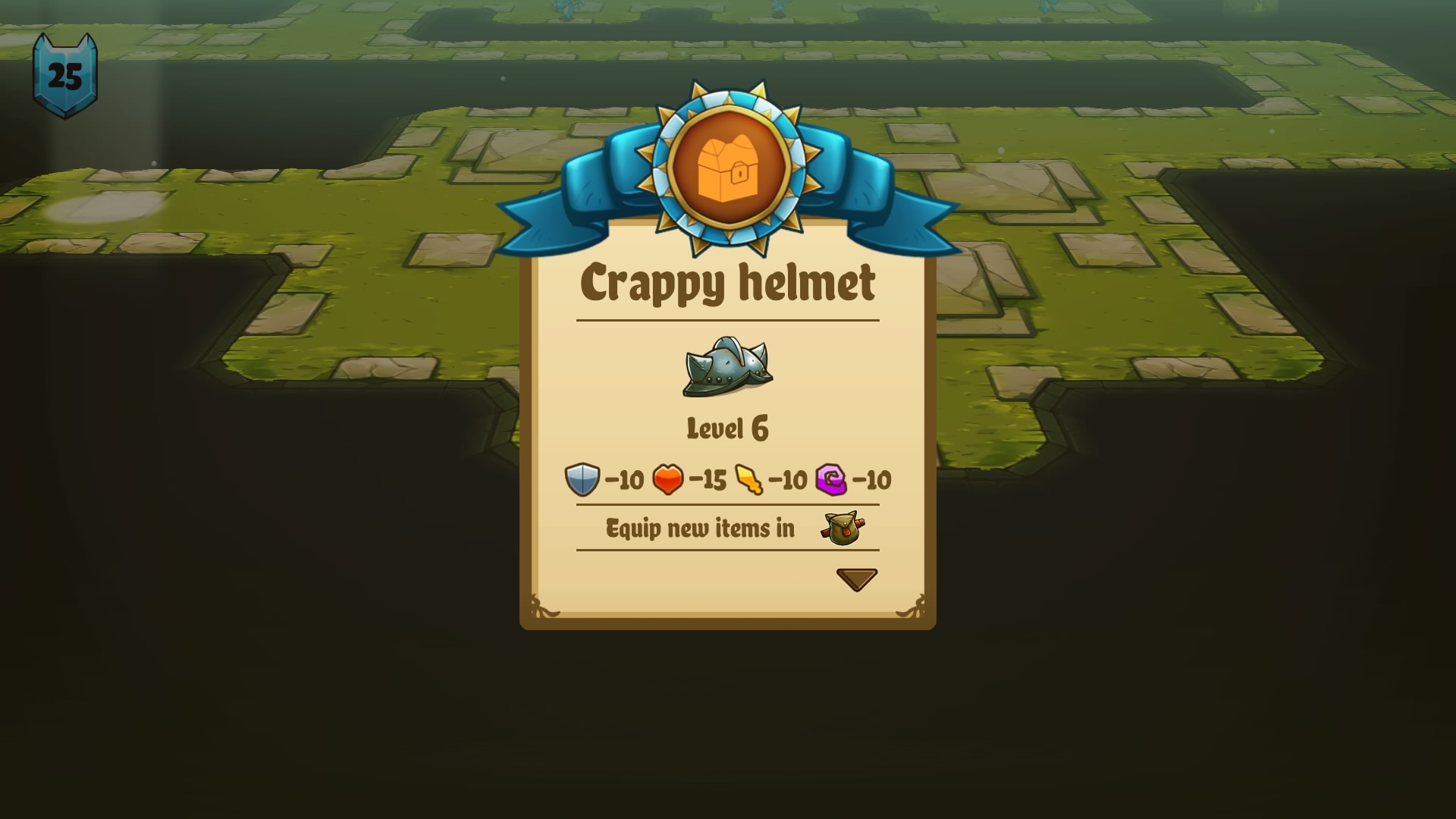
But this system is not without its drawbacks. The auto-leveling mechanic creates a wide swath of disparity in the quality of your equipment, so a lot of the stuff you collect will just never be particularly useful to you. This is further compounded by the player’s potential discovery of the Golden Key, a ludicrously useful tool that—as an unfortunate by-product of its awesomeness—renders at least half of the gear you collect absolutely worthless.
This doesn’t necessarily negatively impact the experience, but it’s a shame to see so many cool weapons and armor pieces go unused.
Cat Charm
While Cat Quest stumbles a bit in some of the mechanical and design delivery of the game, there is one area in which it absolutely 100% nails the delivery: the game is just so damn charming. The Gentlebros went all in on cat puns, to the point that they’re as much a part of the game world as the monsters and caves. And some of them are genuinely great. A few of my favorites include “catventurers,” the “catpital” city, the “Furbidden Forest,” and the aforementioned “Pawcific Ocean.”
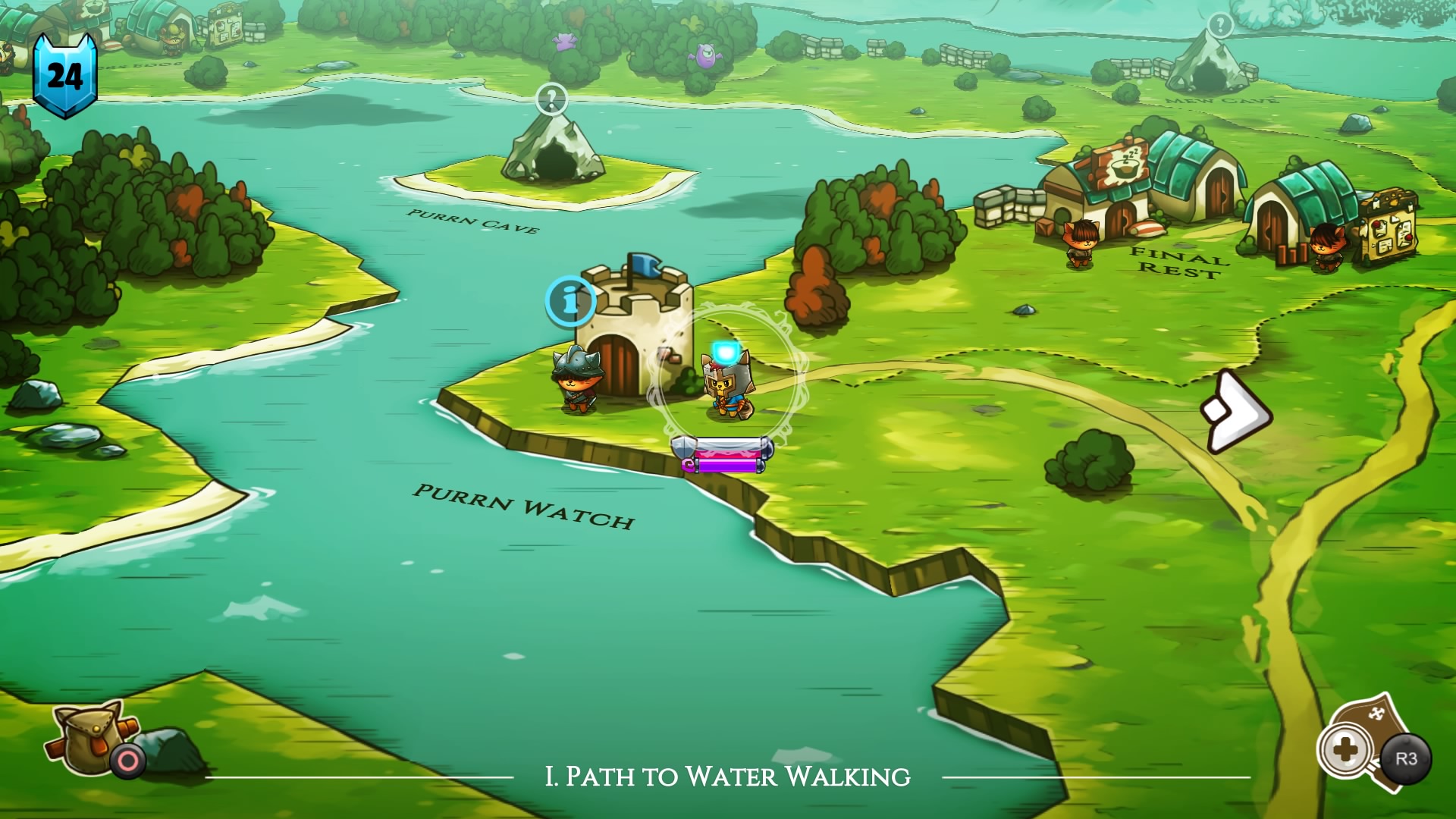
In addition to the punny charm, the Gentlebros also take several opportunities to pull the curtain back and give the player a quick glimpse behind the fourth wall. These moments are fleeting and humorous, and help give shape and weight to the consistent feeling that Cat Quest is a game made by people who genuinely love what they’re doing. For instance, the developers added themselves into the game as NPC’s who provide a pretty entertaining conversation, complete with some tidbits of development history. There are also references to past and (potential) future games, and moments where the characters seem to recognize the narrative tropes that define their actions.
The character models and animations are all delightfully cute, as well as the armor models. I mean, who doesn’t want to see a cat in a wizard hat; or, say, a cat with a cardboard box on its head; or, like, a cat wearing chainmail; or, I don’t know, a cat wearing a top hat and suit?
This review doesn’t even address the overall visual styling and music, because a) both are fantastic and b) there isn’t much I can say that can’t be seen and heard from a YouTube video like this one or this one.
Final Thoughts
Cat Quest isn’t purr-fect (I lied about not using anymore puns.), but it is a ton a fun and truly just a pleasant place to spend 5-10 hours of your time. The combat system, while in need of some balancing to really bring out its full potential, is built on a simple and rock-solid foundation that really is very gratifying. There are some clever systems in place to keep you moving through the game and immersed in the world and combat. Most of all, Cat Quest will charm your socks off and satisfy those looking for a quick dose of 2D RPG nostalgia.
Score: 8.2/10
A Few Quick Notes
1. Cat Quest has a pretty interesting development history, some of which you can read about on the developer’s blog. Look for a feature piece on just this very topic, soon, as we speak with the Gentlebros about the journey from two-player cat dancing game to the award-winning 2D RPG we see, today.
2. For this review, I played Cat Quest on PlayStation 4, but the game is also available on Steam, iOS, Android, and Nintendo Switch.
3. Additionally, if you’re the trophy hunting type, I earned a platinum trophy in approximately 10 hours. Most of the trophies are unlocked through the course of the story, but a few required a bit of grinding (reach level 99, clear all dungeons, collect everything, etc.)
Geron is a freelance journalist currently holed up in the middle of Alaska. He is in love with gaming both for its potential as a medium in the modern world and its simpler role as an endlessly entertaining past time. When he isn't gaming or writing about games, he can usually be found singing loudly to his children or complaining about the cold.
Twitter: @lowsodiumgamer










